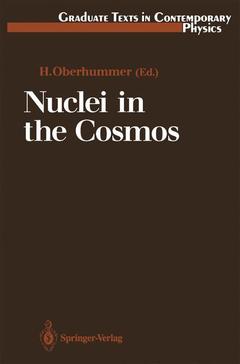Nuclei in the Cosmos, Softcover reprint of the original 1st ed. 1991 Graduate Texts in Contemporary Physics Series
Langue : Anglais
Coordonnateur : Oberhummer Heinz

Nuclear astrophysics as it stands today is a fascinating science. Even though, compared to other scientific fields, it is a young discipline which has developed only in this century, it has answered many questions concerning the under standing of our cosmos. One of these great achievements was the concept of nucleosynthesis, the creation of the elements in the early universe in interstellar matter and in stars. Nuclear astrophysics has continued, to solve many riddles of the evolution of the myriads of stars in our cosmos. This review volume attempts to provide an overview of the current status of nuclear astrophysics. Special emphasis is given to the interdisciplinary nature of the field: astronomy, nuclear physics, astrophysics and particle physics are equally involved. One basic effort of nuclear astrophysics is the collection of ob servational facts with astronomical methods. Laboratory studies of the nuclear processes involved in various astrophysical scenarios have provided fundamen tal information serving both as input for and test of astrophysical models. The theoretical understanding of nuclear reaction mechanisms is necessary, for example, to extrapolate the experimentally determined reaction rates to the thermonuclear energy range, which is relevant for the nuclear processes in our cosmos. Astrophysical models and calculations allow us to simulate how nuclear processes contribute to driving the evolution of stars, interstellar matter and the whole universe. Finally, elementary particle physics also plays an important role in the field of nuclear astrophysics, for instance through weak interaction processes involving neutrinos.
Experimental Determination of Stellar Reaction Rates.- 1. Introduction.- 2. Direct Measurements.- 3. Indirect Approaches.- 4. Reactions Involving Radioactive Nuclides.- References.- Radioactive Ion Beams in Nuclear Astrophysics.- 1. Introduction.- 2. Interest of Radioactive Ion Beams in Nuclear Astrophysics.- 2.1 Nuclear Reactions of Astrophysical Interest Involving Radioactive Nuclei.- 2.2 Indirect Methods.- 2.3 Radioactive Ion Beams Versus Radioactive Targets.- 2.4 Remarks.- 3. Production of Radioactive Ion Beams.- 3.1 The Two Methods.- 3.2 Radioactive Ion Beams Produced by the Two-Accelerator Method.- 3.3 Proposals for RIB Production by the Two-Accelerator Method.- 4. Special Experimental Techniques in Nuclear Astrophysics Using Radioactive Ion Beams.- 4.1 Introduction.- 4.2 Targets.- 4.3 On-line Detectors.- 4.4 Off-line Detectors.- 5. Conclusions.- References.- Direct Reaction Mechanism in Astrophysically Relevant Processes.- 1. Introduction.- 2. Qualitative Features of Nuclear Reaction Mechanisms.- 3. Nuclear Reactions in Astrophysical Scenarios.- 4. Optical Potentials.- 5. Theoretical Descriptions of Direct Reactions.- 6. Examples.- 6.1 Transfer Reactions with Non-resonant Behaviour.- 6.2 Transfer Reactions with Resonant Behaviour.- 6.3 Direct Capture.- 7. Summary.- Acknowledgements.- References.- Nuclear Reaction Rates — from Laboratory Experiments and in the Stellar Plasma.- 1. Introduction.- 2. Theoretical Models for Extrapolating Measured Data.- 2.1 Example: The 12C(?,?)16O E1 Capture Reaction.- 2.2 The 12C(?,?)16O E2 Capture at Astrophysical Energies.- 3. Electron Screening in Laboratory Experiments.- 4. Screening Effects in the Plasma.- References.- Abundances in Galaxies.- 1. Introduction.- 2. Big Bang Nucleosynthesis and Light Element Abundances.- 3. Abundance Trends Between and Across Galaxies.- 4. Stellar Populations in Our Galaxy.- 5. Differential Abundance Variations Among Elements.- References.- Nuclei in Cosmic Rays.- 1. Introduction.- 2. Techniques for Measuring Composition from Satellites and Balloons.- 2.1 Electronic Detectors: The “Chicago Egg”.- 2.2 An Emulsion Experiment: JACEE.- 3. Results of Satellite and Balloon Experiments.- 4. How to Measure Cosmic Ray Composition above 1015 eV.- 4.1 Outline of Extensive Air Showers.- 4.2 Extensive Air Shower Properties Sensitive to Primary Particle Mass.- 4.3 A Proposed Experiment: KASCADE.- 5. Summary.- References.- Primordial Nucleosynthesis: Beyond the Standard Model.- 1. Introduction.- 2. Standard Primordial Nucleosynthesis.- 3. Observational Tests of the Standard Model.- 3.1 Helium.- 3.2 Lithium.- 4. The QCD Phase Transition.- 5. Neutrinos in the Early Universe.- 5.1 Sterile Neutrinos.- 5.2 Neutrino Oscillations.- 6. Cosmic Strings.- 7. Conclusions.- References.- Production of Heavy Elements in Inhomogeneous Cosmologies.- 1. Introduction.- 2. The QCD Transition in the Early Universe.- 3. The Standard Big Bang.- 4. Inhomogeneous Big Bang Scenarios.- 4.1 Light Element Production.- 4.2 The Formation of Heavy Elements.- 5. Computational Method.- 5.1 Inhomogeneous Big Bang in a Two Zone Model.- 5.2 The Nuclear Network.- 5.3 Important Reaction Rates and Their Determination.- 6. Results.- Acknowledgements.- References.- The s-Process: Branchings and Chronometers.- 1. Introduction.- 2. Chronometers — Models and Reality.- 3. s-Process Concepts.- 3.1 The Classical Approach.- 3.2 Stellar s-Process Models.- 4. s-Process Time Scales.- 4.1 Helium Shell Burning.- 4.2 Remixing to the Interstellar Medium and the Age of the Galaxy.- 4.3 Summary of Potential Chronometers.- 5. Selected Examples.- 5.1 176Lu — a Defect Cosmic Clock.- 5.2 The Branchings at 185W and 186Re — Neutron Density and r-Process Age.- 6. Conclusions.- References.- Beta Decay Far from Stability and Double Beta Decay, and Consequences for Astrophysics.- 1. Introduction.- 2. Calculations of Beta Decay Properties of Nuclei Far from Stability.- 2.1 Half-lives.- 2.2 ?-Delayed Fission and ?-Delayed Neutron Emission.- 3. Beta Decay Far from Stability and the Astrophysical r-Process.- 3.1 Synthesis of Heavy Elements in the Universe.- 4. The r-Process and the Age of the Universe.- 5. Age of the Universe, Cosmology and Neutrino Mass.- 6. Double Beta Decay and Neutrino Mass.- 6.1 Neutrino Mass and Particle Theories (GUTs, SUSYs).- 6.2 Double Beta Decay and Neutrino Mass.- 7. Conclusion.- References.
Date de parution : 06-2012
Ouvrage de 236 p.
15.5x23.5 cm
Disponible chez l'éditeur (délai d'approvisionnement : 15 jours).
Prix indicatif 52,74 €
Ajouter au panierThèmes de Nuclei in the Cosmos :
© 2024 LAVOISIER S.A.S.



